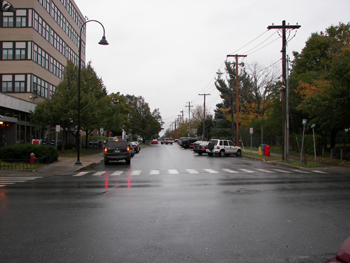

 |
|
|
Northerly view of Elmwood Avenue from the intersection at Pearl Street, L.L. McAllister, April 27, 1931 In this image, one can clearly see the elms for which Elmwood Avenue was named. This photo was taken prior to the repaving and reconstruction of Elmwood Avenue, which took place in 1931. As stated in a copy of this photograph published in the Burlington Annual Report for 1931, one can "note the rough appearance of the surface and high crown as indicated by the tilt of the parked cars". The extent of the project is detailed in the Annual Report: the "old stone curbing" was reset, stone gutters were removed, "old water-bound macadam pavement was salvaged from the road surface, and replaced with a six-inch concrete base topped by a "Stone-Filled-Sheet-Asphalt wearing surface".[1] A short section of The Washington Asphalt Paving Association's "Asphalt Pavement History" clarifies these terms. Macadam paving was made up of small angular gravel laid together and 'bound', or compacted without use of an artificial binder, such as tar, all laid over a substrate of larger angular stones. The first macadam road built in America was constructed in Maryland in 1823. Sheet asphalt roads were made up of everything noted in the Annual Report: a four- to six-inch concrete base, depending on the traffic level on the road, and a wearing surface of tar-covered angular stone asphalt. This road type was introduced in America at Newark, New Jersey in 1870.[2] On the left side of the street, the lighting and a trellis fence for the Texaco filling station built on the corner of Elmwood and Pearl in 1930 can be seen. This site was previously occupied by a large two and a half story dwelling, which was moved further up Elmwood to the corner of Peru Street, where it still stands at number 71 today.[3] Immediately behind the filling station stands number 15 Elmwood Avenue. This two and a half story, gable-front dwelling was the home of Ella Waterman at the time of the photo. Ella’s husband, John, a partner in Berry-Hall Company, purveyors of tea, coffee, spices and other dry goods, had died four years earlier. John had bought the house in 1904 from Harriet Worcester, widow of the Reverend John W. Worcester, junior. This house, as far as can be gathered from maps and directories, was built in 1894 for Harriet, who had previously been living at number 25 with her parents-in-law.[4] Further back, one can glimpse number 25. This building was originally two and a half stories when it was built, circa 1845, when Catherine Fleming built it as a girls’ boarding and day school. After she married Reverend John H. Worcester in 1851, it became known as the Worcester School for Girls. The school operated from 1845 until 1870. John and Catherine remained until their deaths in 1897 and 1901, respectively. In 1909 the roof was raised to three-and-one-half stories and the two-story porch on the front façade was added in 1911. Since the Worcesters passed away, the building has served as a boarding house and apartments, as it was at the time of the photo. [5] On the opposite side, number 30 Elmwood Avenue can be seen. Discussion of this house will continue in another image, as it is more visible in that photograph than it is here.
[1] City of Burlington Annual Report, 1931; 207 and 208. [2] WAPA Ashpalt Pavement Guide: Asphalt Pavement History. [3] Historic Guide to Burlington Neighborhoods, Vol. 1; 185-6. [4] Burlington City Directories, 1890-1931. Sanborn Fire Insurance Map, Burlington, 1894. [5] Historic Guide to Burlington Neighborhoods, Vol. 1; 185-6.
|
Northerly view of Elmwood Avenue from the intersection at Pearl Street, Kurt Jergensen, October 18, 2005. UTM 0642052, 4926836 (NAD 83) In this image, the Federal Building that stands at the corner of Elmwood Avenue and Pearl Street, which houses the Post Office and other Federal offices, dominates the view. The Texaco station at numbers 3 and 5, and the houses at numbers 15 and 19 were all demolished to make way for the construction of the Federal Building. Also note the lack of Elm trees, and the fire hydrant at the corner of Elmwood and Pearl, which still exists.
|
|
L.L. McAllister's Elmwood Avenue Photographs Historic Burlington Project |